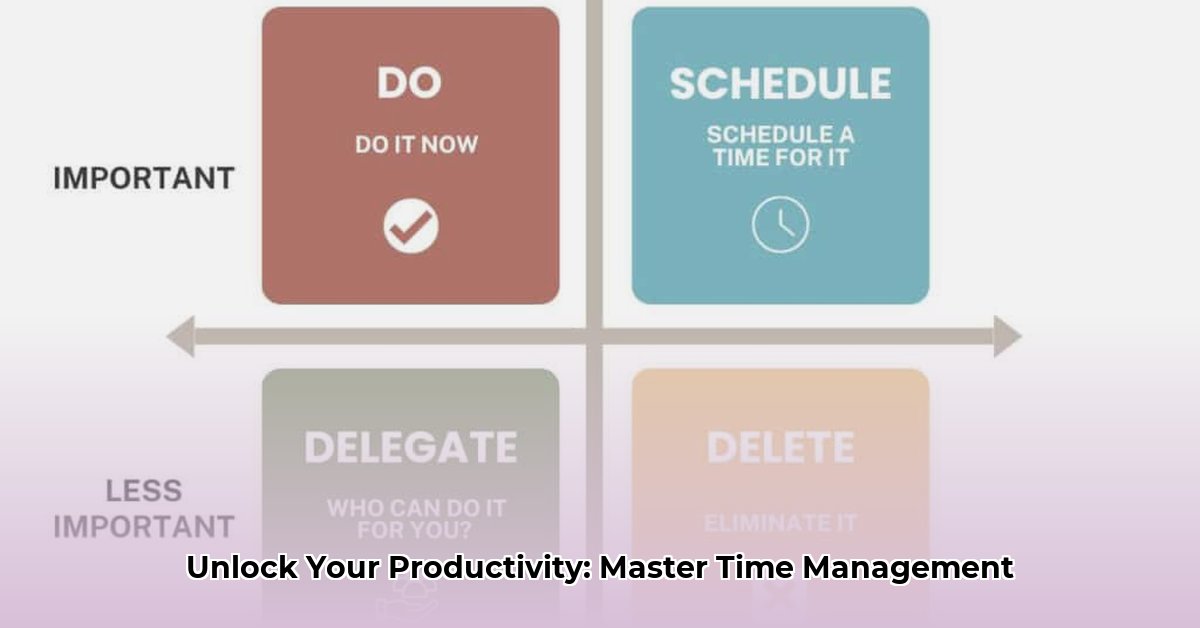Drowning in to-dos and feeling like you’re always playing catch-up? You’re not alone. This guide shows you a simple but powerful system – the Eisenhower/Covey Matrix – to take control of your time and actually get things done. We’ll break it down step-by-step, showing you how to prioritize tasks, avoid common pitfalls, and build a better, more balanced life. You’ll learn practical strategies, discover tips from experts, and even get advice on how to use this method for long-term success – both at work and at home. Ready to ditch the overwhelm and start achieving your goals? Let’s get started!
Time Management Matrix: Your Key to Productivity
Ready to ditch the overwhelm and finally feel on top of things? The time management matrix, also known as the Eisenhower Matrix or Urgent-Important Matrix, can help. It’s a simple but powerful tool that sorts your tasks by urgency and importance, boosting your productivity big time. Think of it as your personal task-wrangling superhero cape.
At its core, the Time Management Matrix is a 2×2 grid, categorizing tasks based on two key criteria: Urgency and Importance. This allows for a clear visual representation of what demands immediate attention versus what contributes to long-term goals.
Understanding the Four Zones of Your To-Do List
The matrix divides your tasks into four distinct quadrants, each requiring a different approach:
-
Quadrant 1: Urgent and Important (Do First): This is crisis central – think burning deadlines, unexpected problems, and those “oh no!” moments. These demand immediate attention and are often unavoidable. Examples include a critical system outage, a last-minute client request, or a health emergency.
-
Quadrant 2: Important but Not Urgent (Schedule): This is where the magic happens. These are the tasks building your future – strategic planning, relationship building, preventative maintenance (think regular car check-ups, not just fixing a flat tire after a blowout), learning new skills, and proactive project management. This is the key to long-term success and less stress. Activities such as writing a business plan, taking an online course, or networking with industry peers fall into this category.
-
Quadrant 3: Urgent but Not Important (Delegate): These are often distractions – some meetings, certain emails, unnecessary interruptions, and minor requests. These create a false sense of urgency, pulling you away from what really matters. Often, these can be delegated or simply deferred. Examples include responding to non-critical emails, attending unproductive meetings, or handling trivial administrative tasks.
-
Quadrant 4: Not Urgent and Not Important (Eliminate): These are time-suckers – busywork, mindless scrolling, excessive social media use, and anything that doesn’t contribute to your goals. These should be tackled with swift and decisive action…the trash can is their friend. Think of activities like excessive TV watching, browsing social media without purpose, or playing mindless games.
Mastering the Time Management Matrix: A Step-by-Step Guide
Let’s break it down into easy-to-follow steps so we can achieve operational excellence:
Step 1: Brain Dump. Write down everything on your plate – big or small. Get it all out of your head and onto paper (or a digital document). No judgment here – just a complete list of everything you need to tackle. Use project management software to organize existing tasks.
Step 2: The Urgency/Importance Assessment. For each item, ask yourself: How urgently does this need to be done? How crucial is this to my long-term goals or well-being? Be honest – no sugarcoating! Consider the consequences of not completing the task and its impact on your overall objectives.
Step 3: The Sorting Hat. Assign each task to one of the four zones. This might take some thought, but it’s worth the effort. Be objective and avoid the temptation to classify tasks as “urgent” simply because they are unpleasant.
Step 4: Zone 2: The Foundation. This is your focus area. These tasks prevent future problems and build toward your long-term success and happiness. Schedule dedicated time for these—and protect it! Think of it as your “me-time” for success. Treat these appointments with yourself as sacred and non-negotiable.
Step 5: Zone 1: Firefighting with Purpose. Handle these urgent tasks efficiently. But don’t let them completely dominate your day. Effective, rapid response is key here. Analyze the root causes of these urgent issues to prevent them from recurring.
Step 6: Zone 3: Delegation Nation. Learn to delegate tasks effectively – this frees up your time for more important things. This isn’t about being lazy; it’s about strategic prioritization. Identify team members who possess the skills and capacity to handle these tasks effectively.
Step 7: Zone 4: The Elimination Game. These are energy vampires. Cut them out. Be ruthless, and reclaim your time. Block access to time-wasting websites and apps during work hours.
The Power of Proactive Planning (Zone 2)
Why the big focus on Zone 2? Because it’s where you prevent problems instead of always reacting to them. It’s the difference between putting out a fire and installing a fire alarm. Neglect this zone, and you’ll likely find yourself constantly putting out fires, always playing catch-up. This proactive approach leads to greater control and reduced stress.
Think of it like this: Zone 2 tasks are like preventative maintenance. It may not seem urgent, but skipping it means bigger problems (and more stress) down the line. Ignoring these vital steps can lead to missed opportunities, increased risk, and ultimately, failure to achieve your long-term goals.
Potential Challenges and How to Overcome Them
Let’s be real – using this system isn’t always smooth sailing. Here are a few common hurdles and suggestions on how to overcome them:
-
Subjective Importance: What’s important to one person might not be to another. Align your tasks with your personal goals to avoid feeling lost or overwhelmed. Regularly review your goals to ensure they remain relevant and meaningful.
-
The Urgency Bias: We often overestimate how urgent things are. Learn to differentiate between true urgency and cleverly disguised distractions. This is a learned skill—be patient with yourself. Implement strategies such as setting boundaries, turning off notifications, and dedicating specific time blocks for focused work.
-
Zone 2 Neglect: Many people struggle with consistently scheduling time for Zone 2 tasks. Schedule this time and treat it as non-negotiable – as essential as any other appointment you have. Visualize the long-term benefits of these tasks to reinforce their importance.
-
Difficulty Delegating: Some individuals struggle to delegate tasks, fearing a loss of control or a decline in quality. Trust your team members, provide clear instructions, and offer support when needed.
Making the Time Management Matrix a Habit
The time management matrix isn’t a one-time fix; it’s a lifestyle change. Review and adjust regularly. Your goals and priorities will shift over time—that’s okay. The key is consistent application. The more you use it, the better you’ll become at prioritizing effectively, reducing stress, and dramatically improving your productivity. It’s an investment in a calmer, more productive you, one well-managed task at a time.
Consider using a digital time management tool to help you implement the matrix. Apps like Trello, Asana, or Todoist can be customized to create a visual representation of the matrix, making it easier to track and manage your tasks.
How to Overcome Eisenhower Matrix Subjectivity in Prioritizing Tasks
Let’s face it: deciding what’s truly “important” can be tricky. The Eisenhower Matrix, while brilliant, relies on your judgment. How do you conquer this subjectivity and truly master your time? Let’s explore some practical strategies.
Defining “Importance” for You
The first step in conquering subjectivity is clarifying your definition of “importance.” What truly moves the needle in your life or business? Is it revenue generation, team morale, personal growth, or something else? Write it down! This becomes your North Star, guiding your prioritization decisions.
For example, if your core value is “customer satisfaction,” then tasks directly impacting customer experience should be classified as highly important.
Objectifying Importance: Metrics and Goals
Instead of relying solely on gut feeling, quantify your “importance” criteria. Define measurable goals. If your goal is increasing revenue, track sales figures. If it’s team morale, maybe you track employee satisfaction scores. These metrics provide objective benchmarks against which to measure task importance.
Set SMART goals (Specific, Measurable, Achievable, Relevant, Time-bound) to provide a clear framework for evaluating task importance.
The Power of Perspective Shifting
Sometimes, a fresh perspective helps. Imagine looking at your task list from a future self’s vantage point. What will your future self consider more important? This exercise can reveal long-term priorities you might overlook when caught in the urgency of the moment.
Consider questions like: “What tasks will contribute most to my career growth in the next year?” or “What activities will have the biggest impact on my personal well-being in the long run?”
Refining Your Eisenhower Matrix System
Regularly review and refine your Eisenhower Matrix workflow. What’s working, and what’s not? Are you accurately predicting urgency and importance? Are you consistently putting the right tasks in
- Corporate Wellness Programs Cost Factors Impacting Your Company Budget - December 18, 2025
- Unpacking the Cost of Wellness Programs and Their Real Value - December 17, 2025
- How Much Do Wellness Programs Cost Businesses To Offer? - December 16, 2025
















